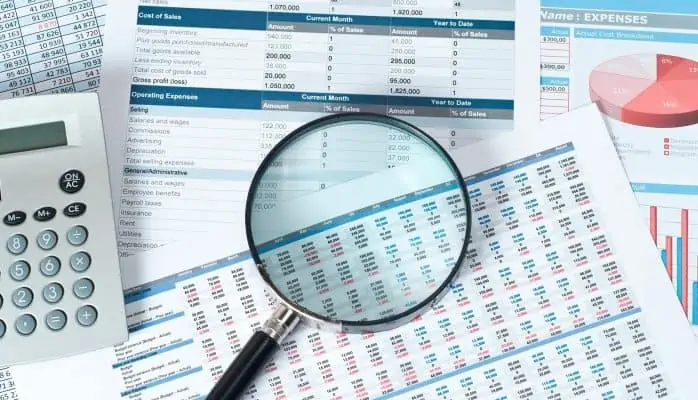
Your business’s success depends on your awareness of its financial situation. Financial reporting, which is an impartial method of evaluating the financial health of your firm, is one instrument that can be useful.
A financial statement from financial reporting can show whether your business is making money or is in difficulty. Let’s examine the fundamentals of financial information and its application.
What are financial statements?
Financial statements are a collection of records demonstrating your business’s financial standing at a given period. They provide essential information regarding the assets and debts of your business as well as its earnings and expenses.
The four main financial statements are as follows:
- balance sheet
- income statement
- cash flow statement
- statement of retained earnings
Financial statements may cover different timeframes. Annual financial statements represent the most recent fiscal year of the business. Companies can also prepare interim financial statements on a monthly, quarterly, or semi-annual basis.
There are situations when interim statements have fewer components than year-end statements. For instance, they might not have a cash flow statement or a statement of retained earnings. Financial statements often include data for the most recent and prior periods to facilitate comparisons.
Why financial statements are important
Financial statements are essential for stakeholders, including shareholders, creditors, and regulators, to understand a company’s overall financial performance and health. Lenders will review your financial statements when you’re prepared to apply for business finance to evaluate whether you qualify for a loan.
Public enterprises must also submit an annual report with their financial results.
Typically, financial statements provide information about a business:
- Economic resources and obligations
- Earning capacity
- Potential cash flows
- Management status
- Accounting policies
Most significantly, financial statements support owners’ decision-making by enhancing their understanding of their bottom lines. Economic statement generation can be facilitated by using appropriate tools, such as accounting software.
The process used to create financial statements
Since financial statements are one of the primary economic data sources, you must follow fundamental accounting rules to guarantee correctness and coherence. There are three principles you can use to create financial statements.
- Documented facts
You can prepare financial statements with an original or historical cost of accounts. Usually, you record prices and the initial cost of any assets you buy at various times.
- Accountancy practices
Your financial statements are comparable and realistic when they follow accounting conventions. For instance, the consistency principle mandates that accountants apply rules consistently over time.
- Personal evaluations
Your financial statements are based on subjective assessments and assumptions to prevent overstating assets and liabilities. Let’s look at the numerous reports that make up financial statements now that you are familiar with the idea of financial statements.
Three types of financial statements

Although there are many tools available to business owners in the realm of financial reporting, the utility belt of a business owner often contains three essential items:
Balance sheet
Assets, liabilities, and equity balances are listed on a balance sheet, often known as a statement of financial status. It displays a company’s financial standing at a specific time. Assets, liabilities, and equity are the three categories that are detailed in a balance sheet.
- Assets are resources that help a business make money through sales and revenue. A vehicle is an example of a tangible asset. Intangible assets include patents and other intellectual property.
- Accounts payable (current liabilities) and long-term debt are examples of amounts the company owes to third parties that are considered liabilities.
- The gap between assets and liabilities, or equity, represents the actual value of a company. Common stock, additional paid-in capital, and retained earnings are all considered equity. Equity can be referred to as owner’s equity, shareholder equity, or net wealth.
The balance sheet formula drives the three balance sheet components. To calculate equity, the formula subtracts assets from liabilities. This is the formula:
Equity = Assets – Liabilities.
The accounting equation must remain balanced while transactions are posted in a double-entry accounting system. Working capital and other significant ratios are calculated using balance sheet accounts.
How are a balance sheet and an income statement related?
The net income account serves as the link between an income statement and a balance sheet. The income statement formula, which calculates net income by deducting revenue from expenses, can be used by a business to produce its income statement. This is the formula:
Revenue – expenses = net income (net profit)
Because the account balances reset to zero at the end of each month and year, income statement accounts are called temporary accounts. Balance sheet accounts, however, remain ongoing. The closing amounts carry over to the following month.
The books are closed at the end of each month, and all revenue and spending accounts are reset to zero. The balance sheet’s net result of the activities shown in the income statement is a rise in equity and a posting of net income.
Income statement
An income statement displays the earnings and outlays for a given period for a business. It offers data on investment returns, risks, financial flexibility, and operational skills. The income statement formula produces an income statement. Most companies create a multi-step income statement detailing how they generate net money.
What distinguishes a multi-step income statement?
A multi-step income statement finds the operating income after the gross profit for a specific period. Consider that you are a small furniture maker preparing a multi-step income statement for May. The majority of your company’s activity will be driven by gross profit.
Your labor, overhead, and material costs are recorded in the price of products sold account. You made $900,000 in material and labor expenditures on the sale of $1,200,000 in furniture in May.
As a result, you earned a $300,000 gross profit. But to run your business in May, you also spent the following expense line items: advertising costs, sales commissions, and home office costs. Let’s imagine that for the month, the charges came to $170,000.
You can calculate your $130,000 operating income for May by deducting your $300,000 profit from your $170,000 expenses.
Comparing operating and non-operating income
Regular business operations can help you make operating revenue. Furniture sales generated an active income of $130,000 in May. Additionally, your business developed a non-operating income of $4,000 from the sale of equipment and $2,000 in interest income.
Your May net income is now $136,000 as a result. Operating income is sustainable. Thus your company must generate most of its net revenue from these sources. Non-operating income fluctuates and is uncertain. No business can depend on it to create yearly profits.
Review the income statement for the fiscal year ending December 31, 2021, for the Centerfield corporation. $520,000 in sales was made, and $420,000 was spent on sales-related expenses. A $100,000 gross profit was the result. Additionally, Centerfield’s operational costs were $90,000.
As a result, they had an operating income of $10,000. The company’s operating income represented its net income balance because it did not produce any non-operating income.
Cash flow statement

The cash flow statement (the statement of changes in financial position) documents a company’s cash inflows and outflows. Cash flow separates into three categories.
Operating activities describe the sources and uses of money for a company’s everyday operations. Cash from client sales and inventories are two examples of operating activities. A company’s cash inflow should come from ongoing business operations, which it can maintain over months and years.
Cash transactions involving purchasing and selling assets like machinery, equipment, and automobiles are investing activities.
Financing activities occur when a business makes money through selling bonds or stock. Repayments in cash to investors are also included in the finance category.
In a business, the operating category is where most cash activity occurs. An accountant should start by identifying the investing and financing transactions before creating the cash flow statement. The active category contains all of the remaining monetary activities.
Review the cash flow statement for the fiscal year that concluded on December 31, 2021, for Centerfield. Notably, the cash balance at the conclusion ($40,000) matches the cash balance on the balance sheet.
How a cash flow statement relates to a balance sheet
The idea of cash flows adds all cash inflows and outflows to determine the net change in cash for a period. The cash flow statement’s ending cash balance should match the balance sheet’s closing cash balance.
Creating more accurate financial statements
The superb strategy to improve the reliability and accuracy of your financial statements is to automate the procedure whenever it is feasible. For instance, accounting software uses technology to do all the number crunching.
So no more staying up late sorting through stacks of receipts and entering numbers into the adding machine. Selecting and adhering to accounting rules is another strategy to preserve accurate financial accounts.
When comparing current performance to prior years, it can be very unpleasant to become mired in the complexity of various accounting or categorizing techniques. However, there are a few ways to render financial statements unreliable or ineffectual. That is the subject we will examine next.
How can I use financial statements to grow my business, and why are they important?
Financial statements are essential for many reasons and are vital to building your business.
- They are necessary for running your company and making long-term plans. Budgeting, forecasting, and strategic planning all involve financial information. You can keep an eye on interim and yearly financial statements to track your company’s progress, identify significant patterns, and assess how your financial situation compares to goals, plans, and projections.
- According to Godfrey, financial statements may spark conversation and demonstrate whether you’re on the correct route so you can decide where and how to pivot early on. “You might need to raise the gross profit margin if revenues are rising, but the profit margin is declining. You might need to reduce some spending if your expenses exceed your budget.
- Lenders, investors, and other partners utilize financial statements to comprehend a business and its situation. Godfrey explains, “We take our time going through the financials.
“When a set is in place, we don’t merely ignore it or glance at a single piece. We examine it front to back. Every page and line item is reviewed. Annual tax filings are evaluated using financial statements.
Conclusion
If you’ve made it this far, incorporating financial statements into your workflow and operations is the next stage. These statements will not only assist you in running your company more effectively, but they will also point out areas for development and potential for progress.
The key to an external assessment of a company’s financial performance is its financial statements. While the income statement provides information on a firm’s profitability, the balance sheet provides information on the liquidity and solvency of the organization.
A cash flow statement links these two by keeping track of the sources and uses of money. Financial statements show a company’s performance over time compared to its rivals.

Pingback: Accounting Cycle: A Complete Guide For Your Business (2022) – Sourcing Agent Dropshipping News
Pingback: General Ledger: How To Create One (2022) – Sourcing Agent Dropshipping News